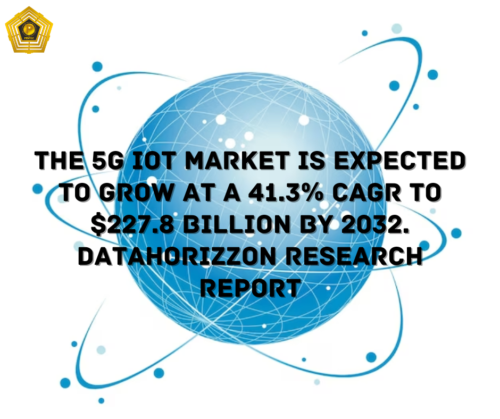DataHorizzon Research estimates that the 5G IoT market would grow at a CAGR of 41.3% from its estimated value of USD 7.2 billion in 2022 to USD 227.8 billion by 2032.
3 October 2023, Fort Collins, Colorado (GLOBE NEWSWIRE) — A research titled “5G IoT Market Size, Growth, Share, Statistics Report, 2016” was released by DataHorizzon Research. Forecasts for 2023–2032 are provided by component (hardware and software, platforms, connectivity, and services), network type (5G standalone vs. 5G non-standalone), organization size, end-user, and region.
DataHorizzon Research estimates that the 5G IoT market would grow at a CAGR of 41.3% from its estimated value of USD 7.2 billion in 2022 to USD 227.8 billion by 2032. The market circumstances and most recent trends are in-depthly examined in the global 5G IoT market study. The most recent industry insights are also included, and potential market prospects are investigated. The development of 5G network technology has changed everything with the growth of the Internet of Things.
Now, IoT devices may operate with maximum performance and dependability. Sensors can connect with actuators, robotics, and drones over the 5G-enabled IoT for improved coordination and blazing-fast task completion. The Internet of Things’s ability to communicate with other gadgets, including computers, tablets, and smartphones, is essential to its commercial viability. IoT devices can share information at lightning speeds thanks to 5G network technologies.
Machine-to-machine (M2M) communications, intelligent data analytics, and IoT technology have profoundly transformed a number of industries. Due to the improved high-speed network supply that allows IoT devices to connect and share data more quickly, the worldwide 5G IoT market is seeing a boom with the introduction of 5G network technology. Higher data speed and bandwidth made possible by 5G IoT offer profitable potential for AI applications that require a lot of computation.
In addition, the vast amounts of data generated by 5G IoT networks enabled the use of deep learning techniques for 5G IoT nodes, including virtual speech recognition, natural language processing, face identification, and video categorization. Customers can now access the internet more quickly thanks to constant car connectivity made possible by 5G IoT, which has also introduced additional capabilities for greater management.
Faster data speeds and increased bandwidth provided by 5G IoT open up possibilities for AI applications that demand powerful computing. Deep learning algorithms for speech recognition, natural language processing, face identification, and video classification can be sent over significant volumes of data via 5G IoT networks. Additionally, 5G IoT makes it possible for continuous car communication, opening up new control features and more effective internet access. Autonomous vehicles, which run autonomously, require high-speed networks with decreased latency, which 5G technology may provide.
Digital methods are being adopted by many companies, and Industry 4.0 is essential for market expansion. Because it enables seamless and scalable connectivity between devices, humans, sensors, mobile robots, automated guided vehicles (AGVs), and drones, wireless communication is crucial for Industry 4.0. Furthermore, 5G enhances industrial automation by providing low-latency real-time machine monitoring.

















